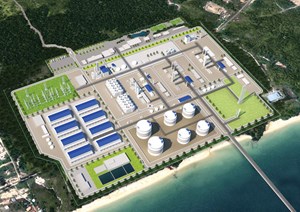News
Samsung Engineering commences Sarawak H2biscus green H2 and ammonia FEED project
Samsung Engineering announced that with LOTTE CHEMICAL, Korea National Oil Corporation and Malaysia's Sarawak Economic Development Corporation Energy (SEDC Energy) the FEED contract for the Sarawak H2biscus green H2 and ammonia project (H2biscus) in Malaysia was launched with a kick-off meeting.
The kick-off meeting was held on the November 23 at Samsung Engineering's headquarters, global engineering center (GEC) in Sangil-dong, Gangdong-gu. Samsung Engineering Executive Vice President & Head of Sustainable Solution Business Division Cheonhong Park, LOTTE CHEMICAL Division Manager Kim Yong-hak, Korea National Oil Corporation Team Leader Jang Jin-hwan, SEDC Energy President Robert Hardin, and other officials from each participating company participated, reviewed major subjects and schedules related to FEED design progress, and shared strategies.
Samsung Engineering will execute the FEED for the green H2 plant with an annual capacity of 150,000 tons and a green ammonia conversion plant with a capacity of 850,000 tons in Sarawak, Malaysia, expected completion in 2024.
Samsung Engineering plans to derive a H2 production method optimized in terms of efficiency and economic feasibility by applying polymer electrolyte membrane (PEM) water electrolysis and alkaline water electrolysis (AFC) technologies, which are representative water electrolysis technologies, at the FEED stage.
This H2biscus project is a project to produce clean H2 based on renewable energy in Sarawak, Malaysia and introduce it to Korea with the participation of Samsung Engineering, LOTTE CHEMICAL, Korea National Oil Corporation and SEDC Energy of Malaysia, launched in early 2022. The project has started and is on track, including signing a renewable power MOU with the Sarawak Electricity Authority in September of the same year.
The H2biscus project is a project to produce and introduce clean H2 based on renewable energy in Sarawak, Malaysia, and is cruising by securing renewable power in September of the same year after starting the project in early 2022. Based on this FEED, a final investment decision final investment decision (FID) will be made at the end of 2024. Once FID is approved EPC is expected to begin right after at the end of 2024 and commercial production of H2 is expected for early 2028.
The alliance on this project predict that H2biscus will greatly contribute to achieving Korea's carbon neutrality goal and revitalizing the H2 economy. Some of the clean H2 to be produced through this project will be used locally in Sarawak, and the rest will be converted to ammonia form and brought into the country to be used in various forms. The Malaysian state of Sarawak plans to contribute to revitalizing the local economy and implement a H2 economy in earnest through the successful development of the H2biscus project.
Hong Namkoong, President and CEO of Samsung Engineering said, “We have taken the first step for carrying out the main project of the H2biscus project, which has great significance both domestically and internationally. We will successfully develop the project as well as the FEED, making H2biscus the role model for global H2 projects.”


